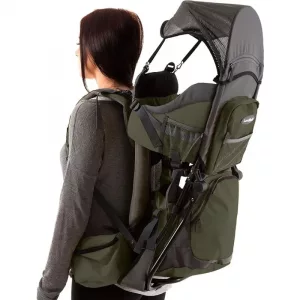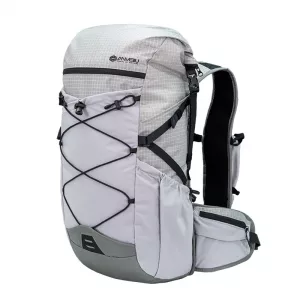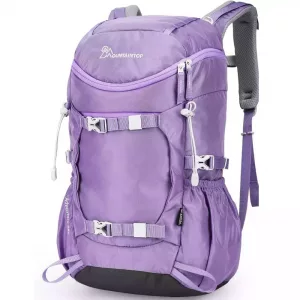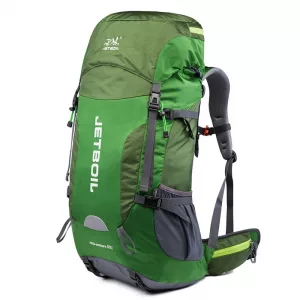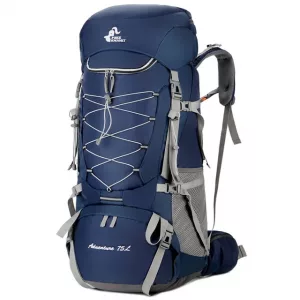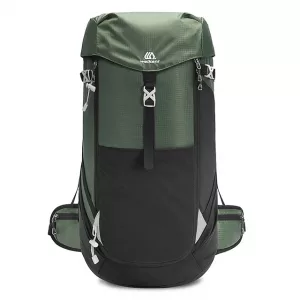Embark on your next adventure with the perfect backpack!
Choosing the right backpack is crucial for a comfortable and enjoyable outdoor experience. This guide from Camp Hike Trail equips you with the knowledge to find your ideal pack, whether you’re conquering a mountain peak or exploring a local trail.

Determine the Purpose
- Everyday Use: For school or work, you’ll need a backpack that fits your laptop, books, and personal items.
- Travel: Look for a travel backpack that has multiple compartments, is carry-on size, and offers comfort for long periods of wear.
- Hiking: A hiking backpack should be durable, have a frame for support, hydration reservoir compatibility, and multiple pockets for gear organization.
- Specialty: Some backpacks are designed for specific activities like cycling, running, or carrying photography equipment.
Key Factors to Consider:
- Activity & Trip Duration: Day hikes, backpacking trips, and travel all require different backpack features. Consider the intensity and duration of your activity when choosing a pack size and features.
- Backpack Capacity: Backpack capacity is measured in liters (L). Daypacks typically range from 15L to 30L, while backpacking packs start around 40L and can go up to 80L or more for extended adventures.
- Torso Fit: A proper fit is essential for comfort and weight distribution. Our backpacks come in different torso lengths (short, regular, tall) to ensure a snug fit on your back. Use our online guide or visit a physical store (if available) to get measured for proper torso length.
- Frame & Suspension System: The frame system transfers weight from your shoulders to your hips for better load carrying. Internal frame packs offer superior weight distribution, while external frame packs prioritize ventilation. Suspension systems vary but typically include padded shoulder straps, hip belts, and load lifters for optimal comfort.
- Weight: For backpacking adventures, a lightweight backpack is crucial. Look for backpacks made with high-quality, lightweight materials. However, ultralight backpacks might compromise on features or durability.
- Features & Compartments: Consider the features you need for your activity. Hydration compatibility, rain covers, sleeping bag compartments, trekking pole attachments, and hip belt pockets are just some features to consider.
Consider the Size
- Small (10-20 liters): Ideal for daily use, carrying essentials like a tablet, small laptop, a book, and some personal items.
- Medium (20-30 liters): Suitable for school or work, accommodating a laptop, books, lunch, and a change of clothes.
- Large (30-50 liters): Best for travel or hiking, providing enough space for multiple days’ worth of clothing, gear, and other essentials.
- Extra Large (50+ liters): Primarily for long hiking trips or travel where you need to carry a lot of gear and supplies.
Evaluate the Fit and Comfort
- Straps: Look for padded shoulder straps that distribute weight evenly. A sternum strap and waist belt can add extra stability and weight distribution.
- Back Panel: A padded and ventilated back panel improves comfort and airflow, reducing sweat buildup.
- Adjustability: Make sure the straps and hip belt are adjustable to fit your body size and shape.
Assess the Features
- Compartments and Pockets: Multiple compartments help organize your items. Consider if you need a laptop sleeve, water bottle pockets, or specialized compartments.
- Material: Durable materials like nylon, polyester, or canvas offer different levels of water resistance and longevity. For outdoor use, consider a backpack with a waterproof cover or made of water-resistant materials.
- Zippers and Hardware: High-quality zippers and buckles are essential for durability and security.
- Accessibility: Consider how easy it is to access your items. U-zip openings, front-loading, or side-access zippers can make a big difference.
Think About Style
- Design: Choose a design that suits your personal style and needs. Minimalist designs are great for urban environments, while technical designs suit outdoor adventures.
- Color: Lighter colors can show dirt more easily, while darker colors are generally more versatile and easier to maintain.
Price Considerations
- Budget: Determine your budget. Basic backpacks can start around $20, while high-end, feature-rich options can go upwards of $200.
- Value for Money: Higher price doesn’t always mean better quality. Look for brands known for durability and good reviews
Camp Hike Trail Backpack Lineup:
At Camp Hike Trail, we offer a wide range of backpacks to suit your needs:
- Daypacks: Perfect for day hikes, casual strolls, or everyday adventures. These compact packs offer essential storage for your gear, water bottle, and snacks.
- Hiking Backpacks: Designed for tackling trails of all types, these packs provide the comfort and support you need for day hikes or overnight adventures with light gear. They offer more storage capacity than daypacks and often include features like hydration compatibility and trekking pole attachments.
- Mountain Packs: Built for extended backpacking trips and challenging terrain, these feature-rich packs prioritize weight distribution and durability. With ample storage space for multi-day essentials, mountain packs ensure you have everything you need to conquer any peak.
Browse our website to explore our extensive pack selection! Use our filters by activity, capacity, and other features to find your perfect match.
Bonus Tips:
- Try before you buy! If possible, visit a store to try on different packs with varying weights to find the most comfortable fit.
- Don’t overload your pack! Aim to keep your pack weight between 10-20% of your body weight for optimal comfort.
- Pack strategically! Place heavier items closer to your back for better weight distribution.
Conclusion
Choosing the right pack involves considering the purpose, size, fit, features, style, and budget. By evaluating these aspects, you can find a backpack that not only meets your needs but also provides comfort and durability for your daily activities or adventures.
With Camp Hike Trail’s guide and backpack selection, you’re well on your way to finding the perfect pack for your next adventure! Happy trails!
Love this gear? Share your adventures with us on Facebook! Join the Camp Hike Trail community and connect with fellow outdoor enthusiasts.
Follow us on Facebook Camp Hike Trail Adventure Gear


